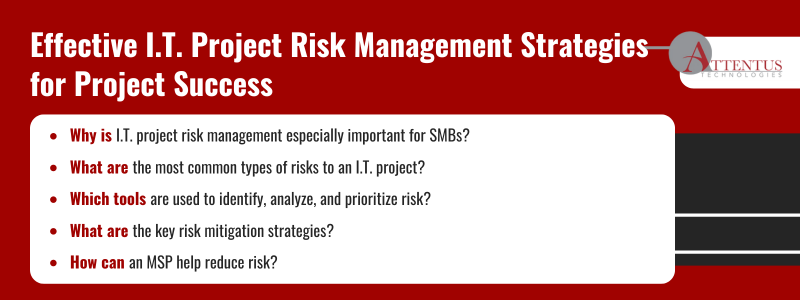Successful project risk management saves time, money, and headaches for your SMB.

Risk management is key to any I.T. project—identifying, analyzing, and responding to risks. For small and medium-sized businesses (SMBs) with limited resources, effective risk management is essential to strategically allocate funds.
Proper project risk management ensures the achievement of project milestones, optimized resources, and budget adherence. On the other hand, poor risk management can lead to negative outcomes in the form of delays, budget overruns, and, sometimes, complete project failure. Successful project risk management is vitally important in an era where 32% of organizations feel exposed to digital and technology risks.
Implementing structured risk management in I.T. projects aims to increase the likelihood of project success by developing risk mitigation strategies. Success is defined as a project that is completed on time, within budget, and to the satisfaction of all stakeholders.
Identifying Risks: The First Step Toward Project Success
Project risk identification means pinpointing potential issues that could affect a project’s timelines, budgets, or quality. This critical step helps to predict difficulties and plan for challenges ahead of time, which means better preparedness and proactive management.
Risk identification is largely built on experience. Partnering with skilled I.T. project managers helps you anticipate and strategize for potential challenges. Identifying risks early in the project lifecycle is not just about prevention; it’s about setting the foundation for project resilience and success.
Common types of risks
Some risks, including fire and natural disasters, can’t be foreseen. However, there are some that I.T. managed services providers (MSPs) see quite often. These include:
- Changes in scope: A project’s scope is specific and documents project goals, tasks, deliverables, costs, and deadlines. However, the scope can alter with evolving requirements, stakeholder input, or new project limitations. Changes in scope lead to increased workloads and adjustments in resource allocation (including money) and planning.
- Budget constraints: If financial resources are limited, this can impact the project pace and the ability to obtain the necessary tools and technologies.
- Resource availability: The project process can be impeded if the necessary equipment, professionals, and other resources are unavailable, which can lead to delays.
- Technological issues: Integration challenges, system failures, or software bugs can disrupt timelines and lead to costly fixes.
Flip Common IT Risks into Business OpportunitiesUncover innovative ways to tackle tech challenges, turning setbacks into success stories. |
The importance of proactive risk identification throughout the project life cycle
I.T. project risk must be managed end-to-end. Proactive risk identification is crucial for the early detection of potential problems and for reducing the likelihood of crisis management. Planned mitigation strategies must be implemented smoothly, and resources must be allocated effectively to risk-prone areas.
The key to effective risk management is open communication between stakeholders and teams. Risk identification and implications must be discussed openly so everyone is on the same page. Continuously identifying risk at every stage means teams can adapt effectively to changes and challenges, contributing to project success.
Tools for risk identification
By leveraging the following tools, I.T. project managers can better understand risks and develop a risk management strategy.
- SWOT analysis: This is a strategic planning tool used by many businesses. It identifies Strengths, Weaknesses, Opportunities, and Threats related to the project. This analysis aims to identify and understand internal and external factors that could impact the project.
- Risk checklists: An experienced MSP has a standardized checklist that outlines the common potential risks based on similar previous projects using historical data and insights.
- Brainstorming sessions: All team members and stakeholders should discuss potential risks to broaden perspectives and foster team cohesion.
Assess and Prioritize Risks
For successful project risk management, risk assessment and prioritization must be discussed. Effective risk management means understanding and aligning the organization’s risk tolerance with project goals to ensure strategic decision-making and business alignment.
A well-structured approach to assessing and prioritizing risks allows everyone involved to better prepare for potential challenges and allocate resources more efficiently, ensuring a higher probability of project success.
What is risk assessment? It’s a detailed evaluation of potential risks to an I.T. project. This includes identifying risks, analyzing the probability of them happening, and understanding their impact on the project. A risk assessment determines which risks require immediate action and which can be monitored as the project progresses.
Risk prioritization
To effectively manage risks, they must be categorized based on the severity of the impact using these categories:
- High severity: Risks that can cause significant delays, cost overruns, or project failure.
- Medium severity: Risks that may cause manageable delays or cost increases within contingency limits.
- Low severity: Risks with minor impact that are usually absorbed in the normal course of project management.
A valuable tool is a risk matrix that helps visualize prioritization by plotting the likelihood of occurrence against the impact should that risk occur. It’s a visual tool that helps quickly identify which risks need immediate intervention and which are less critical to the project.
Metrics for risk assessment
There are two key metrics for risk assessment: probability and impact. Probability assesses how likely a particular risk is to occur. It can be measured qualitatively as high, medium, or low or quantitatively with a percentage or probability score.
Impact measures the potential level of disruption or negative consequences on project objectives. Again, qualitative or quantitative measurements can be used.
Discuss risk appetite
We would all love to live in a world without risk, but the reality is that every project involves an element of risk. Risk appetite refers to the amount and type of risk an organization can tolerate to reach its goals. Various factors can determine risk appetite:
- Business goals: Overall business goals can influence the willingness to take risks – a startup may take more risks to achieve rapid growth, whereas an established company is likely more risk-averse.
- Project scope: A high—priority project may have a lower risk tolerance because its success is mission-critical.
- The external environment, including economic conditions, competition, and regulatory requirements can lower risk appetite.
Effective risk management requires an understanding of risk appetite by both the organization and the MSP. This ensures strategic decision-making and business alignment.
Risk Mitigation Strategies to Minimize the Impact
By understanding and implementing risk mitigation strategies, SMBs can not only protect themselves from potential threats but can also position themselves to respond effectively when unexpected issues arise.
Risk mitigation strategies are either proactive or reactive. By implementing a combination of the following risk mitigation strategies, SMBs can navigate the complexities of I.T. projects smoothly, ensuring better outcomes. Let’s take a look at these strategies and some examples.
Proactive vs. reactive risk mitigation
Proactive mitigation focuses on prevention, using strategies to identify and address potential risks before they turn into actual problems. Proactively identifying risks prevents small issues from snowballing into major project roadblocks—saving time, money, and stress.The goal is to prevent risks from impacting the project through planning and implementing measures that either stop the risk or substantially reduce its potential impacts.
A proactive approach could involve conducting thorough market research and technical feasibility studies before starting a new software development project to ensure the project is viable and the team is equipped with the necessary tools and skills.
Reactive mitigation is damage control. These strategies are used after a risk has become an issue. The focus is on minimizing the damage and recovering as quickly as possible. Applying these strategies requires a deep understanding of the specific I.T. project and the broader business context. SMBs can benefit from a balanced approach that includes a mix of all four strategies.
Flip Common IT Risks into Business OpportunitiesUncover innovative ways to tackle tech challenges, turning setbacks into success stories. |
Key risk mitigation strategies
- Avoidance
Avoiding risks means altering the project’s parameters or scope to eliminate potential problems. For SMBs, this could mean choosing stable, widely supported platforms rather than opting for newer, more innovative tools. - Reduction
Risk reduction aims to decrease the likelihood of a risk or reduce its impact if it were to occur. This is done through well-planned contingency strategies and appropriate resource allocation. - Transfer
Transferring risk involves shifting the risk to a third party, such as through outsourcing or insurance. This is often used for unavoidable risks that can be better managed by specialists.For example, a small business could outsource its I.T. management to an MSP, transferring risks to a company with more resources and expertise.
- Acceptance
Unfortunately, sometimes risks cannot be avoided, reduced, or transferred. In these cases, the business may choose to accept the risk. Acceptance does not mean ignorance – it involves acknowledging the risk and preparing for potential impacts.
Examples of practical applications of risk mitigation strategies
Let’s look at some theoretical examples of how I.T. project risk mitigation strategies are applied in the real world.
- An SMB hires an MSP to overhaul its existing CRM system. Before beginning, a comprehensive risk assessment identifies potential data migration issues, integration challenges with existing I.T. infrastructure, and potential staff training gaps.
- A marketing firm wants to implement a new project management software solution. Working with their MSP, they develop detailed contracts and scope documents that clearly define deliverables, timelines, and responsibilities. Regular review points ensure the project stays on track and any scope creep can be addressed promptly.
- A retail business outsources its network security overhaul to an MSP. They implement a structured communication plan to mitigate risk with weekly updates and regular reviews to discuss project progress, challenges, and adjustments. This ensures all parties remain informed and can take proactive steps if the project deviates from its path.
- A manufacturing SMB is updating its ERP system with an MSP. Before project launch, a detailed backup and disaster recovery plan is established to ensure that operations can continue with minimal interruption in case of system failure during the update process.
Implementing successful risk mitigation project strategies helps reduce risks and builds a strong foundation for the relationship between SMBs and MSPs. This ensures that I.T. projects are delivered on time, within scope, and with the desired quality, ultimately supporting the SMB’s business goals and growth.
Effective Project Risk Management Leads to Project Success
Effective risk management is essential for the success of I.T. projects, particularly for SMBs with limited resources. By proactively identifying, analyzing, and responding to risks, these businesses can prevent potential issues from derailing their projects. Tools like SWOT analysis, risk checklists, and brainstorming sessions are crucial in identifying risks early and accurately.
Assessing and prioritizing risks helps to allocate resources judiciously and align mitigation strategies with the organization’s risk appetite. Comprehensive risk mitigation strategies, including avoidance, reduction, transfer, and acceptance, further safeguard the project’s progress. Continuous monitoring and control of risks ensure that the project adapts to environmental changes, maintaining alignment with set objectives and ultimately securing the desired outcomes within scope, budget, and time.
For expert I.T. project risk management, partner with Attentus Technologies. We make successful project risk management look easy. That’s because we focus on understanding your issues personally and taking a proactive approach to risks that lead to successful project outcomes. One of our core values is building trusted relationships. We don’t see our clients as just a transaction—we see their success as our success. We take the time to understand where they are now and where they want to be, and we work to make that vision a reality.
Let’s work together – SMBs are more profitable when they focus on their core business and leave the heavy I.T. lifting to us. Simply fill out this form to get started.

